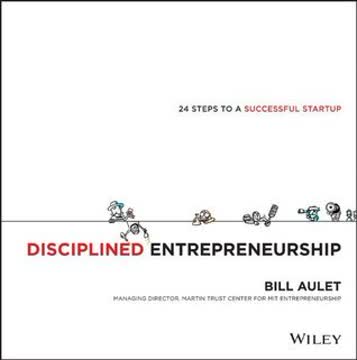Key Takeaways
1. Translate Your Idea into a Compelling Business Model
A business is created in order to execute on an idea. Not having a clear picture of that idea is guaranteed to result in an extraordinary amount of wheel spinning.
Business Model Canvas: Use the Business Model Canvas to visualize and refine your business concept. This tool helps you map out key elements:
- Customer segments
- Value propositions
- Channels
- Customer relationships
- Revenue streams
- Key resources
- Key activities
- Key partnerships
- Cost structure
Scalability: Ensure your business model is scalable by considering:
- Ability to start small
- Decreasing marginal costs over time
- Built-in scalability (not relying on exogenous factors)
2. Craft a Lean Business Plan and Validate with Customers
Planning is about managing change, and in today's world change happens very fast.
Lean Planning Principles:
- Do only what you'll use
- Continuous process, not just a plan
- Assume constant change
- Empower accountability
Minimum Viable Product (MVP): Create a basic version of your product to test with real customers. Use it to:
- Establish baseline metrics
- Test value and growth hypotheses
- Gather customer feedback
Iterate rapidly based on feedback, following the Build-Measure-Learn cycle. Conduct split tests (A/B tests) to compare different versions or marketing approaches.
3. Build Your Dream Team and Allocate Equity Wisely
Equity is forever, so once it's in someone's hands there is no easy way for you to get it back.
Dream Team Components:
- The Entrepreneur: Vision, passion, leadership, risk-taking
- Execution Skills: Technical, sales, marketing, operations
- The Concept: Innovative idea with market potential
Equity Allocation: Use a structured approach like the Founder's Pie Calculator to determine fair equity splits based on:
- Idea contribution
- Business plan preparation
- Domain expertise
- Commitment and risk
- Responsibilities
Implement reverse vesting to protect the company if a founder leaves early.
4. Establish Your Brand and Network Effectively
Because of the extraordinary amplification powers of the Internet, many scalable, high-growth businesses these days are Internet based.
Online Presence:
- Create a professional website
- Establish profiles on key platforms:
- CrunchBase
- Glassdoor
- AngelList
- Gust
Networking:
- Attend industry Meetups
- Participate in business plan competitions
- Join accelerator programs
- Engage with angel groups
- Leverage peer programs like Entrepreneurs' Organization (EO)
5. Incorporate, Lawyer Up, and Set Up Essential Systems
While no one likes to imagine the fourth scenario, which of the first three you aim for can have a significant impact on everything from the type of business you enter to whether and how you finance it, and even what options you have for an exit.
Incorporation:
- Choose a Delaware C Corporation for most high-growth startups
- Work with an experienced startup attorney for proper setup
Essential Systems:
- Accounting: Use cloud-based tools like Xero
- Banking: Open business accounts and establish credit
- Legal: Set up proper contracts and agreements
- Technology: Choose key platforms for productivity and operations
6. Recruit Boards, Hire Employees, and Incentivize with Stock Options
The combination of integrity, competence, and deal-closing ability sets apart the great startup lawyers from those who are merely good.
Board Recruitment:
- Seek board members who provide: Wealth, Work, Wisdom
- Set regular meeting schedules and clear expectations
Hiring:
- Use the New Hire Draft Board to evaluate candidates
- Balance full-time employees with freelancers as needed
Stock Options:
- Establish a stock option plan to attract and retain talent
- Use 409(a) valuations to determine fair market value
7. Understand Funding, Connect with Investors, and Prepare for Exit
Smart investors are on the lookout for customers that are already spending many hundreds of millions—ideally, billions—of dollars, with a growing field of potential customers.
Funding Stages:
- Bootstrapping: $0-$25,000
- Friends & Family: $25,000-$150,000
- Angel Investors: $150,000-$1.5M
- Venture Capital: $1.5M+
Investor Connection:
- Develop a compelling pitch deck
- Leverage professional networks and angel groups
- Participate in pitch competitions
- Consider online funding platforms
Exit Planning:
- Initial Public Offering (IPO)
- Acquisition
- Management of investor expectations and relationships throughout the process
Remember that the ultimate goal is to create value and achieve a successful exit, whether through an IPO, acquisition, or continued growth as an independent company.
Last updated:
FAQ
What's The Startup Checklist about?
- Comprehensive roadmap: The Startup Checklist by David S. Rose is a detailed guide for entrepreneurs aiming to build scalable, high-growth businesses. It outlines 25 essential steps from idea conception to exit strategy.
- Practical focus: The book emphasizes actionable insights over theoretical concepts, making it a practical resource for both new and experienced entrepreneurs.
- Target audience: It is aimed at entrepreneurs who want to build businesses capable of hiring employees, raising funds, and potentially going public or being acquired.
Why should I read The Startup Checklist?
- Avoid pitfalls: David S. Rose shares insights from his experience as a serial entrepreneur and angel investor, helping readers avoid common startup mistakes.
- Comprehensive resource: The book offers 25 actionable steps, serving as a one-stop checklist for entrepreneurs, complete with tools, templates, and online resources.
- Expert insights: Rose distills lessons from advising over 100 startups, making it a valuable resource for navigating the entrepreneurial landscape.
What are the key takeaways of The Startup Checklist?
- Business model importance: Developing a compelling business model is crucial for guiding future decisions and strategies.
- Lean business planning: The book advocates for a lean business plan that serves as a dynamic roadmap, allowing for flexibility and continuous improvement.
- Strong team building: Assembling a founding team with complementary skills is vital, with an emphasis on defining roles and expectations.
What is a Minimum Viable Product (MVP) as defined in The Startup Checklist?
- Basic product version: An MVP is a simplified product version with essential features to test the core idea with customers.
- Hypothesis testing: It tests the value and growth hypotheses, refining the product based on real-world customer interactions.
- Market experiments: Launching an MVP allows entrepreneurs to conduct experiments to gauge customer interest and make informed development decisions.
How do I allocate equity in my startup according to The Startup Checklist?
- Avoid equal splits: Rose advises against equal equity splits among founders to prevent conflicts and resentment.
- Consider contributions: Equity should be based on the original idea, expertise, commitment, and responsibilities of each founder.
- Reverse vesting: Implementing reverse vesting protects the company by reclaiming unvested equity if a founder leaves early.
What is the Lean Business Plan mentioned in The Startup Checklist?
- Dynamic planning tool: The Lean Business Plan focuses on essential elements and is regularly updated and reviewed.
- Actionable insights: It emphasizes what should happen, who is responsible, and costs, encouraging continuous improvement.
- Avoids complexity: By keeping the plan lean, entrepreneurs focus on what truly matters, aligning with lean startup principles.
How can I effectively network within the entrepreneurial ecosystem as suggested in The Startup Checklist?
- Local meetups: Engage in local meetups and networking events to connect with like-minded individuals and potential collaborators.
- Business plan competitions: Participate in competitions for exposure, feedback, and potential funding, with mentorship opportunities.
- Online platforms: Use platforms like Gust and AngelList to connect with investors and other startups, enhancing visibility and network access.
What are the benefits of incorporating my startup as outlined in The Startup Checklist?
- Limited liability protection: Incorporation protects personal assets from business debts, providing peace of mind for founders.
- Fundraising ability: An incorporated entity can issue shares, attracting investors and partners for growth and scaling.
- Credibility and legitimacy: Incorporation lends credibility, making the business more attractive to investors, customers, and partners.
What is the Business Model Canvas mentioned in The Startup Checklist?
- Visual framework: The Business Model Canvas is a strategic tool for developing, describing, and analyzing business models.
- Iterative process: It encourages entrepreneurs to visualize and adjust components, identifying weaknesses and areas for improvement.
- Collaboration tool: The canvas fosters team discussion and alignment on business strategy, leading to innovative solutions.
What are the best practices for managing investor relations as outlined in The Startup Checklist?
- Regular communication: Keep investors informed through regular updates and reports to build trust and engagement.
- Utilize technology: Use investor relations platforms to streamline communication and maintain professional relationships.
- Set expectations: Clearly define communication frequency and content to manage investor expectations and reduce misunderstandings.
How does The Startup Checklist suggest handling hiring and team building?
- Prioritize key roles: Focus on hiring for critical roles based on business needs and founders' skills to operate effectively.
- Utilize freelancers: Leverage freelancers for flexibility and specialized skills without full-time commitments.
- Cultural fit: Emphasize cultural fit during hiring to maintain a cohesive team, using a draft board approach for evaluation.
What is the significance of the liquidation waterfall in The Startup Checklist?
- Payout structure: The liquidation waterfall outlines the order of payouts in liquidation or acquisition, protecting preferred stockholders.
- Investor protection: Understanding the waterfall is crucial for negotiating investment terms and managing expectations.
- Strategic planning: It influences funding rounds and company strategy, impacting payout structure and stakeholder interests.
Review Summary
The Startup Checklist receives positive reviews for its comprehensive, practical guidance on launching and growing a business. Readers appreciate the step-by-step approach, real-world examples, and valuable resources provided. The book is praised for its clarity and usefulness for entrepreneurs at various stages. Some reviewers note its US-centric focus and occasional subjectivity towards investors. Overall, it's highly recommended for startup founders, with many considering it a must-read resource for navigating the challenges of building a high-growth business.
Similar Books










Download PDF
Download EPUB
.epub digital book format is ideal for reading ebooks on phones, tablets, and e-readers.




